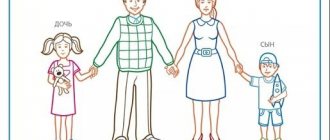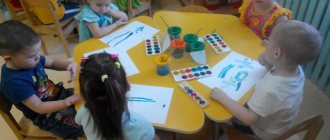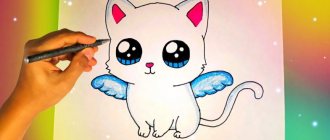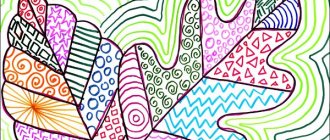Preview:
Department of General Education
of the Rtishchevsky District of the Saratov Region
Municipal preschool educational institution "Kindergarten No. 12 "Zvezdochka". G. Rtishchevo, Saratov region"
Topic: “Bread is the head of everything”
Educator: Kolomiets V.E.
Abstract drawing “Bread is the head of everything”
Goal: To teach children unconventional ways of drawing an ear of wheat.
expand and deepen children’s knowledge about a wheat ear and its appearance.
strengthen your drawing skills using brush bristles.
— increase the motivation of visual activity through awareness of its moral significance; improve gross and fine motor skills.
activate adjectives in children’s speech (yellow, prickly, golden).
Educational objectives: to cultivate independence and focus in work, the ability to complete a job started, accuracy when working with paints. Cultivate a caring attitude towards bread.
The teacher tells the ancient legend about the ear of bread:
— In ancient times, when God himself walked the earth, people’s lives were easy and well-fed. It was summer all year round. When needed, it rained, when needed, the sun shone. Fruit trees grew in the forests. The animals were docile, and all fed on grass. People knew no disease, no troubles, no hunger. The ear of grain was very large - there was almost no stalk, the grains started from the ground itself, and each grain was the size of a bean. There was so much bread that no one valued it. One day God walked the earth and saw how a mother wiped a soiled child with the edge of freshly baked bread and at the same time refused food to the wanderer. God got angry, ascended to heaven and deprived people of bread. The earth became like stone, the rivers dried up, the grass withered. Hunger has set in. Then the cat and dog went to God to ask for bread. He took pity and allocated a small ear on a long stem for the cat and dog's share. God made it so that summer began to occupy only half of the year. Winter is for people, and summer is for animals. When people baked fresh bread, they gave the first piece to cats and dogs. Now tell me, what does the legend teach?
Educator: guys, guess the riddle, “a house grew up in a field, the house is full of grain” (ear of grain). Here is the spikelet as our guest today, let’s tell you what we know about it. Where does the spikelet grow? What plants still grow in the field that have spikelets?
Children: wheat, rye, barley.
Educator: guys, let's look at the picture showing a wheat field. What's on the spikelet?
Children: grains (the teacher demonstrates a natural ear of wheat)
A grain has fallen into the ground (children crouch),
It began to germinate in the sun (arms above head).
The rain watered the ground, and the sprout grew (the children get up slowly).
He was drawn to the light and warmth, and turned into a handsome man.
Educator: children, let's sit down at the table and try to draw a wheat field (first we draw a stalk, and then blot the bristles of the brush.
The teacher asks the children to imagine that he is a spikelet, and they are grains. Children slowly gather in a circle on the carpet, with the teacher in the center.
— Guys, tell me what is made from wheat grains? (different types of flour)
-What are they made from flour? (bakery products)
- Today our spikelet has prepared bread for you.
- When you eat, remember the legend of the ear of bread.
Source
Drawing lesson for children of the senior group “Bread is the head of everything!”
Svetlana Sheypak
Drawing lesson for children of the senior group “Bread is the head of everything!”
Dear Guys! Imagine that we went to a bakery. What a wonderful smell of fresh bread ! On the shelves, loaves, buns, loaves, pies, bagels and puff pastries are neatly laid out in rows. And all this is baked from white wheat flour.
Perhaps there is nothing better than soft wheat bread ! What does wheat look like? It has a dense, hollow stem that holds an ear full of grain. Ripe wheat grains are oblong, yellowish-golden in color, surrounded by a fairly hard shell that protects them from drying out.
Wheat, which is now grown in grain fields , comes in two types: hard and soft. Pasta and vermicelli are made from solids. It is not suitable for baking because it contains little gluten, a substance that gives bread looseness and porosity. Bread is baked from soft wheat, which contains a lot of gluten. In summer, the wheat ear fills with golden ripeness and becomes large and heavy.
Summary of the fine art lesson “Bread is the head of everything” in the preparatory group
Natalya Tarasenko
Summary of the fine art lesson “Bread is the head of everything” in the preparatory group
Summary of a drawing lesson in the preparatory group:
on the theme “ Bread is the head of everything ”
.
Compiled by: N. M. Tarasenko
To consolidate knowledge about the genre of still life painting, to give an idea of composition.
Learn to choose the appropriate color scheme.
Learn to convey the shape, color and size of objects in a drawing.
Learn to harmoniously arrange images on a sheet of paper.
Develop a vision of aesthetic beauty in still life.
Equipment and materials:
Reproductions of still lifes: V. Stozharov “ Bread , salt and brothers”
Photo illustration of baked goods measuring approximately 15x20 cm, cut into fragments.
Sheets of A4 paper
Colored and simple pencils, erasers, felt-tip pens.
Music by P. I. Tchaikovsky “July, August”
from the series
"Seasons"
.
Preview:
Goal: to cultivate a caring attitude towards bread.
Objectives: to remind that bread is everyday
product; continue to learn to think about the content of your future drawing; develop the skill of drawing the outline of an object with a simple pencil with light pressure on it; consolidate the ability to paint over an image; develop imagination and independence.
Materials and equipment: illustrations and drawings on the topic “Bread”,
ears of rye, bakery products, flour, white sheets, simple pencils,
wax crayons, musical accompaniment.
1. Organizational moment.
- Guys, I’ll tell you a riddle now, and you guess it and find out what
Today we will draw.
Everyone calls him the head,
Never throw it on the floor.
In the oven he grew up and became stronger,
This is our favorite...(bread)
- Right. We will draw bread today. (Conversation with children). Let's
Let's look and touch our baked goods (examination). Pay attention to the shape, size, color.
The seed is growing (They squat, clasping their knees with their hands)
The seed is growing - (Squatting, hands pulled up)
Reached for the sun. (Stand up, stretch on tiptoes, hands up)
It plays with the breeze, (Hands up, swaying gently from side to side
The breeze shakes it
He presses low to the ground (Tilting towards his toes) - that’s how fun he plays!
(Straightened up, jumped, hands up).
Invite the children to put sheets of paper in front of them, take simple
pencils, specify that the drawing will be located
all over the sheet of paper.
- Guys, tell me, how will we draw with a simple pencil?
(Answers). Right. To begin with, we will draw an outline using a pencil
You need to press lightly.
When the main details of the drawing have been drawn, offer the children
take wax crayons and color.
4. Make an exhibition for parents.
5. Put workspaces in order.
On the topic: methodological developments, presentations and notes
Summary of a lesson in the senior group on the topic Bread is the head of everything.
I offer you a summary of open direct educational activities for children of the senior group on the topic: “Bread is the head of everything.” This material is useful for teachers of the senior group. Cognitive
let children understand that bread is a daily food product, introduce children to the variety of bakery products, consolidate knowledge about the long journey of bread from field to table, and educate uva.
Give children an idea that bread is a daily food product; introduce children to a variety of bakery products; consolidate knowledge about the long journey of bread from field to table; V.
Give children the idea that bread is a daily product. Tell where bread comes from, how it is made, who grows it and bakes it. To instill respect for the work of adults and respect for bread.
Source
Drawing in the preparatory group. Photo report “Festive loaf”
Victoria Adamenko
Drawing in the preparatory group. Photo report “Festive loaf”
Bread is the head of everything! This is the most famous proverb about bread. Not a single feast or meal was complete without it. Bread is a very satisfying and healthy product on our table.
Since ancient times, many wars and battles began over fertile lands on which rye and wheat were sown and grown. If the enemy set fire to a field in which rye grew, he doomed the local population to starvation.
In the old days in Rus', the harvest of rye and wheat was used to judge how favorable the year would be and whether one would have to live from hand to mouth.
To get to our table, bread travels a long way. Growing bread is a complex and labor-intensive work, starting with the work of agronomists, tractor drivers, grain growers, combine operators, and ending with the baker.
Bread has always had a special meaning in Rus'. with the large and round loaf of bread that was baked for the holidays . Dear guests were greeted and seen off with loaves of bread, and the most beautiful and decorated loaves were the main treat at weddings.
Our goal and objectives are to introduce children to the professions whose people grow and make bread, to expand their understanding of the loaf and bakery products; cultivate a caring attitude towards bread as one of the important food products; develop the ability to draw a circle and an oval , making a composition on them.
Photo report on a drawing lesson for children aged 5–6 years “Ruddy Loaf” Objectives: To clarify what profession people work in, baking bread in bakeries. To consolidate the concept of a loaf, of bakery products. Tasks:.
Summary of a drawing lesson Topic: “Glory to the bread on the table”
Suitable for both adults and children
Drawing lesson notes
Topic: “Glory to the bread on the table”
(with children of the preparatory group)
Purpose:
continue to learn to think about the content of your future drawing; cultivate a caring attitude towards bread.
develop the skill of drawing the outline of an object with a simple pencil with light pressure on it; consolidate the ability to paint over an image (without going beyond the outline, evenly, without gaps, applying strokes in
continue to learn to think about the content of your future drawing;
develop imagination and independence;
cultivate a caring attitude towards bread;
learn to finish what you start.
Materials and equipment:
illustrations and drawings on the theme “Bread”, ears of rye, bakery products, white sheets, simple pencils, sets of colored pencils, musical accompaniment: music to relieve stress).
Educator:
Guys, I’ll tell you a riddle now, and you guess it and find out what we’ll be drawing today.
Guess easily and quickly: soft, fluffy and fragrant,
It’s black, it’s white, and sometimes it’s burnt.” (Bread)
Educator:
Right. We will draw bread today.
Look, on our plate there is a variety of bread made from rye, wheat, and oats. Let's look and touch our baked goods (examination). Pay attention to the shape, color, size.
Let's remember how bread came to our table.
Bread made from wheat is called what?
Rye flour bread? Made from oatmeal? (children's answers).
Now let’s remember once again how bread is grown and baked:
In the spring, who plows the field first? (grain growers).
Sowing with what? (wheat, rye.)
What grows from grain? (ears containing many new grains).
When is the harvest harvested? (autumn)
Who goes out into the field to collect? (combiners)
Who removes grain from the fields? (car, driver).
Where is grain sent for storage? (elevator)
Who can tell me where flour is made? (at the mill).
Where is the bread baked? (bakery).
Then the bread appears where? (shops, hospitals, kindergartens.)
The seed is growing (They squat, clasping their knees with their hands)
A seed is growing (They are squatting, arms pulled up)
Reached for the sun. (Stand up, stretch on tiptoes, hands up)
It plays with the wind, (Hands up, swaying quietly from side to side)
The breeze shakes it
Presses low to the ground (Tilt towards toes)
- that's how fun it is to play! (Straightened up, jumped, hands up).
1. Invite the children to put sheets of paper in front of them, take simple pencils,
clarify that the sheet is large and the drawing will be located across the entire sheet of paper.
- Guys, tell me, how will we draw with a simple pencil? (Answers).
Right. To begin with, we will draw an outline; you need to press the pencil lightly so that
our drawing lines were barely noticeable; there was no need to paint over them. (Musical accompaniment: music to relieve stress).
When the main details of the drawing have been drawn, invite the children to take colored
pencils and color. Remember that strokes must be applied in one direction, without going beyond the contour, evenly, without gaps. Encourage the use of different colors, clarify that different shades of color can be achieved by using different pressure
Enjoy beautiful drawings with your children. Make an exhibition for parents. Tidy up your workspaces.
- What did we draw today?
— What did you like most?
Material number: DB-1241547
Didn't find what you were looking for?
You might be interested in these courses:
Summary of a lesson in fine art in the preparatory group “Bread, bakery products”
Elena Papenkina
Summary of a lesson in fine art in the preparatory group “Bread, bakery products”
Summary of a lesson in fine arts in the preparatory group “ Bread , bakery products ”
1. Teach children to think about the content of their work based on personal experience.
2. Clarify and consolidate children’s knowledge about bakery products .
3. Develop the ability to convey the shape of familiar objects, their proportions, using previously learned modeling techniques.
Material and equipment: Images and illustrations on the topic “ Bread ”
, models
of bakery products , salted dough, oilcloths, stacks, “Magic wand”
.
Preliminary work: reading Prishvin’s “Fox Bread ”
, Musatov A. - How
bread came to the table , G. Lagzdynia “The Adventures of
the Bread Man ” , S. Shurtakov
“The grain fell into the ground”
, Belarusian folk tale
“Light
Bread ” .
Learning sayings about bread , looking bakery products in a bread store (excursion to a bread store , reading poems by D. Kugultinov “A Piece of
Bread ” , H. Mänd
“
Bread ” , K. Kubilinskas
“Sheaves”
, the story by E. Shim
“
Bread Grows ” .
1. Organizational moment.
Little Red Riding Hood comes to visit the children, she explains to the children that she forgot the pies that her mother baked, and which she should take to her grandmother, somewhere in the forest when she was picking flowers.
The teacher calms Little Red Riding Hood and invites the children to help Little Red Riding Hood bake a treat for grandma.
— Guys, let's help Little Red Riding Hood?
But first I want to play a game with you called “Magic Wand”
.(the wand is passed around in a circle, the child holding the magic wand names
the baked goods .)
Educator: Well done guys, you know so much about baked goods , please tell me, what do baked goods ? Where does flour come from? What grain crops do you know? (wheat, rye, barley, oats, and who bakes bread ? (bakers)
Leave your comment
Responsibility for resolving any controversial issues regarding the materials themselves and their contents is taken by the users who posted the material on the site. However, the site administration is ready to provide all possible support in resolving any issues related to the work and content of the site. If you notice that materials are being used illegally on this site, please notify the site administration using the feedback form.
All materials posted on the site were created by the authors of the site or posted by users of the site and are presented on the site for informational purposes only. Copyrights for materials belong to their legal authors. Partial or complete copying of site materials without written permission from the site administration is prohibited! The opinion of the administration may not coincide with the point of view of the authors.
Source









